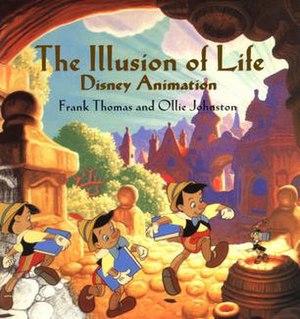
Disney's twelve basic principles of animation were introduced by the Disney animators Ollie Johnston and Frank Thomas in their 1981 book The Illusion of Life: Disney Animation.[a][1] The principles are based on the work of Disney animators from the 1930s onwards, in their quest to produce more realistic animation. The main purpose of these principles was to produce an illusion that cartoon characters adhered to the basic laws of physics, but they also dealt with more abstract issues, such as emotional timing and character appeal.
The book has been referred to by some as the "Bible of animation",[2] and some of its principles have been adopted by traditional studios. In 1999, The Illusion of Life was voted the "best animation book[...] of all time" in an online poll done by Animation World Network.[3] While originally intended to apply to traditional, hand-drawn animation, the principles still have great relevance for today's more prevalent computer animation.
- ^ Thomas, Frank; Ollie Johnston (1997) [1981]. The Illusion of Life: Disney Animation. Hyperion. pp. 47–69. ISBN 978-0-7868-6070-8.
- ^ Allan, Robin. "Walt Disney's Nine Old Men & The Art Of Animation". Animation World Network. Archived from the original on November 2, 2013. Retrieved October 21, 2011.
- ^ "List of Best Animation Books". Animation World Network. Archived from the original on September 3, 2009. Retrieved October 21, 2011.